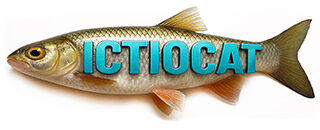Peix gat
Ameiurus melas

El peix gat a les nostres aigües assoleix unes mides màximes de 25-30 cm El cos és de color molt fosc, quasi negre, i no està recobert d’escates. El cap és molt ample i aplanat, amb quatre parells de barbetes al voltant de la boca. L’aleta dorsal i les pectorals tenen radis espinosos. L’aleta caudal és poc forcada i tenen una aleta adiposa al peduncle caudal.
És una espècie originària d’Amèrica del Nord, que va ser introduït fa anys a Catalunya, però actualment és poc abundant.
Habita en aigües estancades o de poc corrent. Tolera aigües amb poca concentració d’oxigen i una mica contaminades. S’alimenten d’invertebrats i restes vegetals.
Distribució

Peix gat puntejat
Ictalurus punctatus

És un peix de mida gran que pot arribar a fer més d’1 m de longitud amb un pes superior als 15 kg. El cos és de color gris fosc o verdós, més fosc en els adults, i amb petits punts negres quan són joves. Té 4 parells de barbetes envoltant la boca. Es diferencia del peix gat en el fet que l’aleta caudal és profundament forcada. El primer radi de l’aleta dorsal i de les aletes pectorals és espinós i molt esmolat.
És una espècie nativa de Nord-amèrica que a Catalunya va aparèixer l’any 1995 al baix Ebre, on s’hi ha establert tot i que en baixa abundància.
Viu en embassaments i als rius mitjans i grans de corrent lent. Es reprodueix a la primavera. Els progenitors fan un niu entre troncs submergits o altres restes vegetals. S’alimenten de peixos, insectes, crustacis i mol·luscs.
En ser un depredador voraç pot representar una amenaça per a la ictiofauna autòctona.
Distribució

Silur
Silurus glanis

És un peix que pot superar fàcilment els 2 m de longitud i més de 100 kg de pes. La longevitat també és elevada, poden viure més de vint anys. El cos és allargat i comprimit lateralment en la seva meitat posterior. El cap és aplanat i ample, amb uns ulls molt petits i una gran boca envoltada de 6 barbetes. Color del cos molt fosc, marró o negre a la part dorsal amb taques fosques irregulars als costats.
El silur és originari de l’est d’Europa i Àsia central, però s’ha introduït en molts altres països d’Europa pel seu interès de pesca, com és el cas de Catalunya, on es pot trobar al riu Ebre i en alguns trams del Ter i del Llobregat.
Habita en rius profunds de corrent lent, llacs i embassaments. Es reprodueix a la primavera, moment en què els mascles construeixen un niu entre la vegetació o restes vegetals. Té costums nocturns o crepusculars, i durant el dia descansa entre la vegetació o troncs submergits. Quan són joves s’alimenten d’invertebrats, però molt aviat comencen a depredar peixos i altres vertebrats, que constitueixen el seu aliment principal.
La introducció il·legal del silur ha causat un fort impacte sobre algunes espècies autòctones per culpa de la seva gran voracitat.
Distribució

